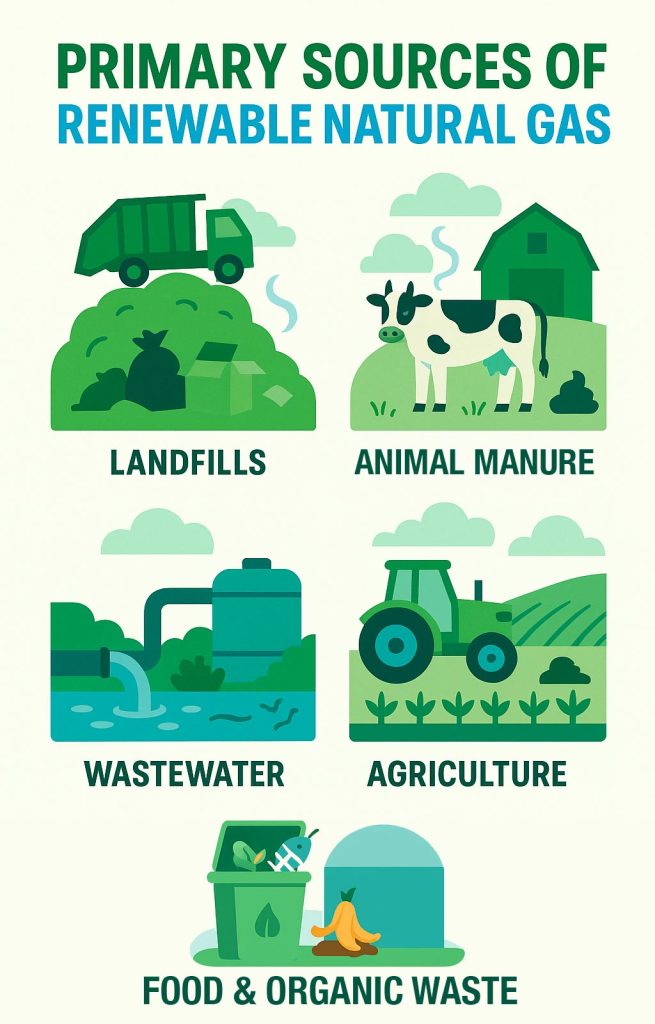Key Takeaways
- Renewable natural gas is made from organic waste (like manure, food scraps, and landfill trash), capturing harmful methane emissions and converting them into usable energy.
- By replacing fossil natural gas, RNG reduces greenhouse gases, sometimes even becoming carbon-negative when it prevents methane from entering the atmosphere.
- RNG can be used just like traditional natural gas, for heating, electricity, and fueling vehicles, without needing major infrastructure changes, making it a practical green solution.
Renewable natural gas (RNG) is a clean, eco-friendly version of traditional natural gas. But unlike regular natural gas (which comes from fossil fuels dug up from the earth), RNG is made from organic waste. Yep, stuff that would normally rot away, like food scraps, animal manure, or even wastewater, gets a second life as energy.
RNG is chemically almost identical to fossil natural gas (methane), so it can be used in the same way, for heating, cooking, electricity, and transportation. The big difference? Instead of pulling more carbon from underground, RNG recycles emissions that would otherwise escape into the atmosphere. That makes it a carbon-neutral or even carbon-negative energy source, depending on how it’s produced.
How Is RNG Made?

Imagine all the organic waste from farms, landfills, and food processing plants. Instead of letting it decompose and release methane (a potent greenhouse gas) into the air, we capture it and clean it up. Here’s how it works:
- Collection: Waste from farms, landfills, or food waste is gathered.
- Decomposition: Micro-organisms break down the waste, producing biogas (a mix of methane and CO₂).
- Purification: The biogas is cleaned up to remove impurities, leaving nearly pure methane, aka RNG!
- Compression or Liquefaction: Depending on the application, the biomethane is compressed (for CNG fuel) or liquefied (for LNG) for storage and transport.
- Distribution and End Use: Now it’s ready to be used just like regular natural gas, for heating, electricity, or even fueling vehicles.
The process is called anaerobic digestion when done in controlled environments (like digesters on farms), or landfill gas recovery when capturing emissions from decomposing trash. After purification, RNG meets pipeline standards and can be blended with conventional gas or used on its own.
Sources of RNG: Where Does It Come From?
RNG can be produced from almost any organic waste that releases methane as it breaks down. Some of the biggest sources include:

Animal Waste: A growing source in agricultural regions.
- How it works: Manure from dairy farms, hog farms, and other livestock operations is placed in an anaerobic digester, where bacteria break it down to release biogas.
- Why it’s used: Reduces odors, limits methane emissions, and provides farmers with fertilizer byproducts.
- Common uses: Fuel for power plants, onsite heat, or upgrading to RNG for transportation or pipeline use.
Landfills: Largest current source of RNG in the U.S.
- How it works: Landfills naturally produce methane as organic waste decomposes underground. This methane is captured through a series of wells and pipes.
- Why it’s used: Prevents methane (a potent greenhouse gas) from leaking into the atmosphere and turns it into usable energy.
- Common uses: Power generation, heating, or pipeline injection after cleanup.
Wastewater Treatment Plants: A widely used source in urban areas.
- How it works: Organic solids from wastewater are processed in anaerobic digesters at treatment facilities, producing biogas.
- Why it’s used: Turns a waste stream into a valuable energy product while reducing treatment plant emissions.
- Common uses: Electricity generation, heat for plant operations, or upgrading to RNG.
Food & Beverage Industry: Helps cities meet waste diversion goals.
- How it works: Organic waste from restaurants, food processors, and municipal programs is digested similarly to manure.
- Why it’s used: Diverts food waste from landfills, reducing methane emissions and landfill burden.
- Common uses: Renewable fuel for transportation, heating, or power generation.
Forestry & Crop Residues: Less common today but growing in Europe and pilot projects in the U.S.
- How it works: Crop residues (like corn stalks or wheat straw) or dedicated energy crops (like switchgrass or wood chips) are processed anaerobically.
- Why it’s used: Offers another income stream for farmers and uses non-food biomass for energy.
- Common uses: Often co-digested with other organic waste streams for higher yields.
Emerging Sources:
- Thermal gasification of biomass (turning woody biomass into a gas and refining it into RNG)
- Algae-based systems
Farm-based RNG is especially promising because managing manure in digesters not only produces energy but also reduces odors and water pollution. Landfill gas capture is another major contributor, turning trash heaps into energy hubs instead of methane super-emitters.
Why Is RNG Awesome?
Here’s why RNG is a big deal:
- Reduces Waste: Instead of letting organic waste pile up in landfills, we turn it into something useful.
- Cuts Greenhouse Gases: Capturing methane (which is way worse than CO₂ for the climate) helps fight global warming.
- Works with Existing Systems: Since RNG is chemically similar to fossil natural gas, it can use the same pipelines and appliances.
- Cleaner Fuel for Vehicles: Many trucks and buses now run on RNG, cutting down on diesel pollution.
Beyond these benefits, RNG supports local economies, farmers and waste facilities can earn extra income by selling biogas. It also provides a steady energy supply since organic waste is constantly being produced. And because RNG can replace fossil fuels without major infrastructure changes, it’s a practical step toward decarbonizing industries that are hard to electrify, like long-haul trucking.
Where Is RNG Used?
In some places, RNG is injected directly into natural gas pipelines, blending seamlessly with conventional gas. Waste management companies and cities are increasingly using RNG to power garbage trucks and buses, creating a closed-loop system where waste fuels its own collection. Industries with high heat demands (like cement and steel production) are also exploring RNG as a cleaner alternative to coal or oil. You might already be benefiting from RNG without even knowing it! It’s being used for:
- Heating homes & businesses
- Generating electricity
- Powering vehicles (especially heavy-duty trucks and buses)
- Industrial processes
The Future of RNG
As more companies and cities push for greener energy, RNG is getting more attention. It’s not the only solution to climate change, but it’s a smart way to reduce waste and emissions at the same time.
Government incentives, corporate sustainability goals, and advances in biogas technology are driving RNG growth. Some experts believe it could supply up to 10-15% of global natural gas demand in the coming decades. The key challenges? Scaling up production cost-effectively and ensuring that RNG comes from truly sustainable sources, not farms that overproduce waste just for energy.
Renewable natural gas is like turning trash into treasure, helping the planet while keeping our energy supply reliable. The next time you hear about RNG, you’ll know it’s all about making energy cleaner, smarter, and more sustainable.
FAQs About Renewable Natural Gas
Is natural gas renewable?
How is RNG different from regular natural gas?
Is RNG actually better for the environment?
Can RNG be used in existing gas appliances?
Why isn’t RNG used everywhere yet?
About the Author
LaLeesha has a Masters degree in English and enjoys writing whenever she has the chance. She is passionate about gardening, reducing her carbon footprint, and protecting the environment.
